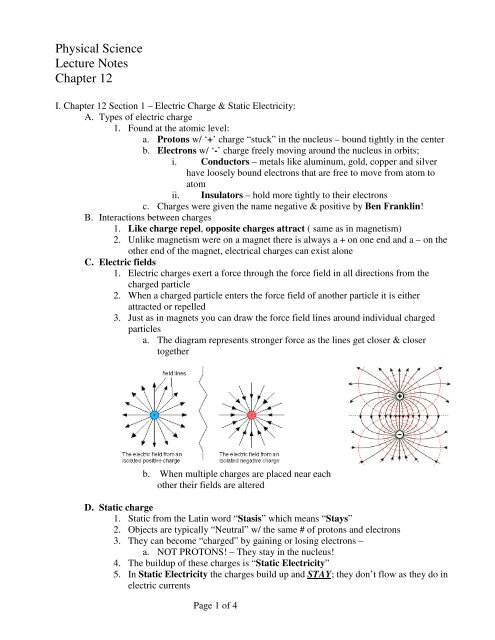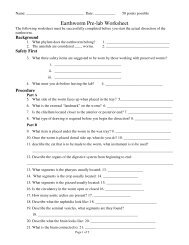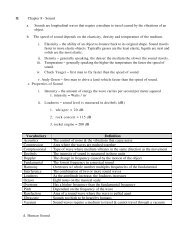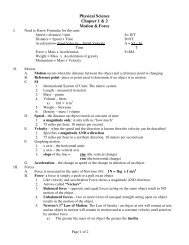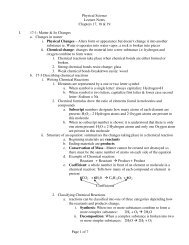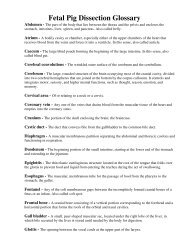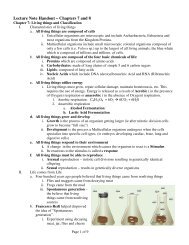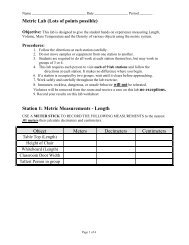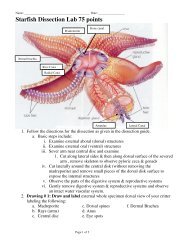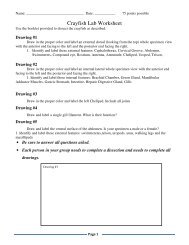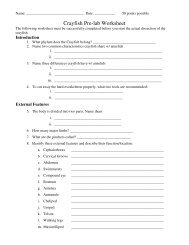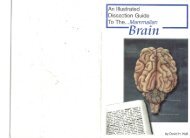Physical Science Lecture Notes Chapter 12 - Mr.E Science
Physical Science Lecture Notes Chapter 12 - Mr.E Science
Physical Science Lecture Notes Chapter 12 - Mr.E Science
- No tags were found...
You also want an ePaper? Increase the reach of your titles
YUMPU automatically turns print PDFs into web optimized ePapers that Google loves.
<strong>Physical</strong> <strong>Science</strong><br />
<strong>Lecture</strong> <strong>Notes</strong><br />
<strong>Chapter</strong> <strong>12</strong><br />
I. <strong>Chapter</strong> <strong>12</strong> Section 1 – Electric Charge & Static Electricity:<br />
A. Types of electric charge<br />
1. Found at the atomic level:<br />
a. Protons w/ ‘+’ charge “stuck” in the nucleus – bound tightly in the center<br />
b. Electrons w/ ‘-’ charge freely moving around the nucleus in orbits;<br />
i. Conductors – metals like aluminum, gold, copper and silver<br />
have loosely bound electrons that are free to move from atom to<br />
atom<br />
ii. Insulators – hold more tightly to their electrons<br />
c. Charges were given the name negative & positive by Ben Franklin!<br />
B. Interactions between charges<br />
1. Like charge repel, opposite charges attract ( same as in magnetism)<br />
2. Unlike magnetism were on a magnet there is always a + on one end and a – on the<br />
other end of the magnet, electrical charges can exist alone<br />
C. Electric fields<br />
1. Electric charges exert a force through the force field in all directions from the<br />
charged particle<br />
2. When a charged particle enters the force field of another particle it is either<br />
attracted or repelled<br />
3. Just as in magnets you can draw the force field lines around individual charged<br />
particles<br />
a. The diagram represents stronger force as the lines get closer & closer<br />
together<br />
b. When multiple charges are placed near each<br />
other their fields are altered<br />
D. Static charge<br />
1. Static from the Latin word “Stasis” which means “Stays”<br />
2. Objects are typically “Neutral” w/ the same # of protons and electrons<br />
3. They can become “charged” by gaining or losing electrons –<br />
a. NOT PROTONS! – They stay in the nucleus!<br />
4. The buildup of these charges is “Static Electricity”<br />
5. In Static Electricity the charges build up and STAY; they don’t flow as they do in<br />
electric currents<br />
Page 1 of 4
6. Transferring Static Charge – 3 ways: Friction, Conduction & Induction<br />
a. Friction – transferred from rubbing i.e. get shocked after walking on the<br />
carpet<br />
b. Conduction – transferred by direct contact w/ another object – hair<br />
standing on end w/ Van de Graff machine<br />
c. Induction – the force field of a highly negatively charged object pushes the<br />
electrons away from nearby objects causing them to become + charged,<br />
they then are attracted to each other. i.e. statically charged balloon attracts<br />
small pieces of torn up paper<br />
Friction Conduction Induction<br />
Small strips of<br />
torn paper are<br />
attached to the<br />
negative charge<br />
on the balloon<br />
E. Static discharge<br />
1. Objects don’t hold a static charge forever – objects tend toward equilibrium –<br />
they “want” to be neutral<br />
2. When electrons move toward this equilibrium – static discharge occurs<br />
3. Humidity – water (a polar molecule) vapor in the air pulls electrons off negatively<br />
charged objects, preventing static charges to build up<br />
4. Sparks & Lightning –<br />
a. Rubbing your feet on the carpet pulls electron off you and you become +<br />
charged. When you touch the door knob electrons jump off and shock you.<br />
b. In thunder clouds the bottoms of the clouds become negatively charged<br />
while the upper parts of the clouds become positively charged<br />
i. Most lightning is a giant “spark” between or within the clouds to<br />
reach equilibrium.<br />
ii.<br />
The land below the clouds is positively charged and sometimes<br />
the spark jumps from the clouds to a “high”<br />
point on the ground – lightning bolt occurs<br />
F. Detecting charges<br />
1. Electric charge detected w/ an electroscope<br />
II. <strong>Chapter</strong> <strong>12</strong> Section 2 – Circuit Measurements<br />
A. Flow of electrons through a material is an electric current<br />
B. Electrical Potential –<br />
1. Similar to potential energy (lifting something higher against<br />
the force of gravity gives it greater potential to do work,<br />
increasing its potential energy.) When given the opportunity,<br />
electroscope<br />
objects will move from higher potential energy to an area of lower potential energy<br />
2. In a similar way electrons in a circuit have potential energy. This potential is<br />
related to their electrical fields and not o height – Electrical Potential<br />
3. Electrons want to travel from areas of high Electrical Potential to areas of low<br />
Electrical Potential. This provides the energy to push a charge through a circuit<br />
and light a light bulb.<br />
C. Voltage<br />
1. Volt – unit of measure to measure this potential –<br />
2. Voltage – causes current to flow through an electrical circuit<br />
Page 2 of 4
D. Voltage sources<br />
1. The potential for water to flow through a pipe depends on the difference in height:<br />
1<br />
2<br />
3 In #1- the pipe is nearly level, very little<br />
potential (difference) & water dribbles out<br />
In #2- a greater angle allows more water to<br />
potentially pour out<br />
In #3- the greater angle between top &<br />
bottom, the faster the water flows<br />
2. A Voltage Source (battery or generator) is required to maintain the electrical<br />
potential in a circuit.<br />
3. Just as a greater difference in height allows a greater flow of water, an increase in<br />
voltage causes a greater flow of electrical current.<br />
1<br />
2<br />
In #1- the pipe has a large diameter and allows a<br />
large current to flow with very low resistance<br />
In #2- the smaller diameter offers greater<br />
resistance and less current can flow through it.<br />
greater the resistance, the less current<br />
greater the current, the less resistance<br />
E. Resistance – the opposition to the flow of electricity – measured in Ohms<br />
1. Water flowing thru a pipe depends on more than the angle of the pipe. It also<br />
depends on the length of the pipe, diameter of the pipe and if the pipe is clogged or<br />
open.<br />
2. Electrical current is measured in Amperes<br />
3. Amount of Electrical Current ( amps) depends on more than just Voltage, it<br />
depends on the Resistance found in the circuit.<br />
4. The greater the resistance, the less current there is for a given voltage.<br />
a. Longer wires have greater resistance than short wires<br />
b. Thin wires have more resistance than thick wire<br />
c. High conductors have less resistance than insulators<br />
5. Electricity will take the path of least resistance<br />
F. Ohm’s law<br />
1. Resistance = Voltage / Current<br />
2. Ohms = Volts /Amps<br />
3. Volts = Amps x Ohms<br />
4. Amps = Volts / Ohms<br />
V = Voltage = volts<br />
I = Current = Amps<br />
R = Resistance = Ohms<br />
Series<br />
Series<br />
Parallel<br />
Parallel<br />
Page 3 of 4
III. Standard symbols of an electrical diagram<br />
IV. <strong>Chapter</strong> <strong>12</strong> Section 3- Series & Parallel Circuits<br />
A. Series circuits – provides only one path for the electrons to follow<br />
1. A break in the circuit stops the flow of electricity to all other parts of the circuit<br />
2. With multiple light bulbs (more resistance) the current reduces & the dimmer the<br />
lights become<br />
3. Ammeters should be wired in series<br />
B. Parallel circuits – the different parts of the circuit are on separate branches<br />
1. A break (burn out light bulb) in the circuit doesn’t stop the flow to the remaining<br />
devices<br />
2. The more paths the LESS the resistance<br />
a. Water example again: added pipes coming from a large tank will allow<br />
more water to flow out that a single pipe.<br />
b. Therefore as resistance decreases, current increases; they are inversely<br />
proportional<br />
3. Multiple light bulbs will remain the same brightness since the resistance is not<br />
decreasing as it does in a series circuit.<br />
4. Each pathway can be separately switched off w/out affecting the others<br />
5. Voltmeters are wired in parallel<br />
C. Household circuits – Wired in parallel, with a standard of <strong>12</strong>0 volts<br />
Page 4 of 4


